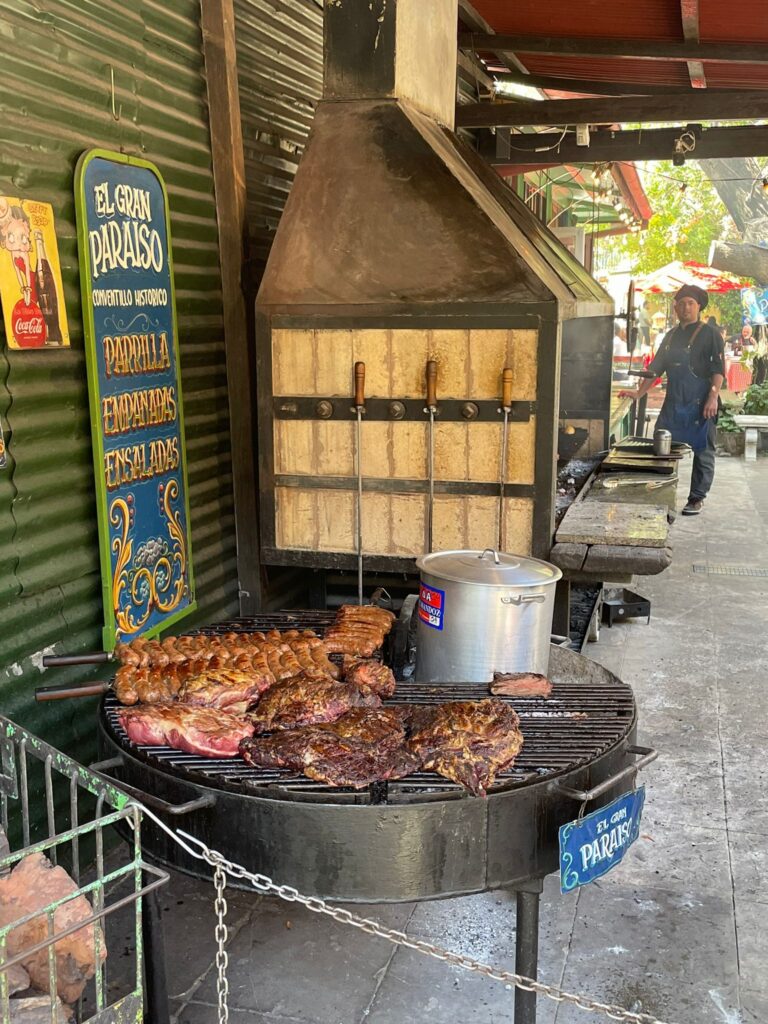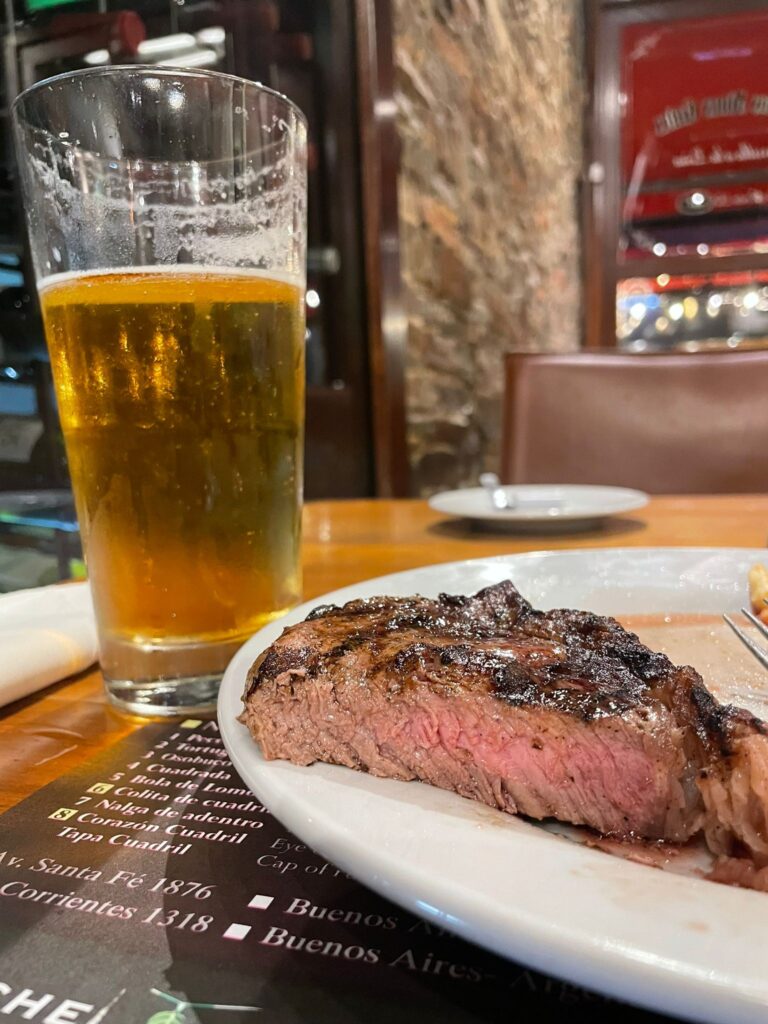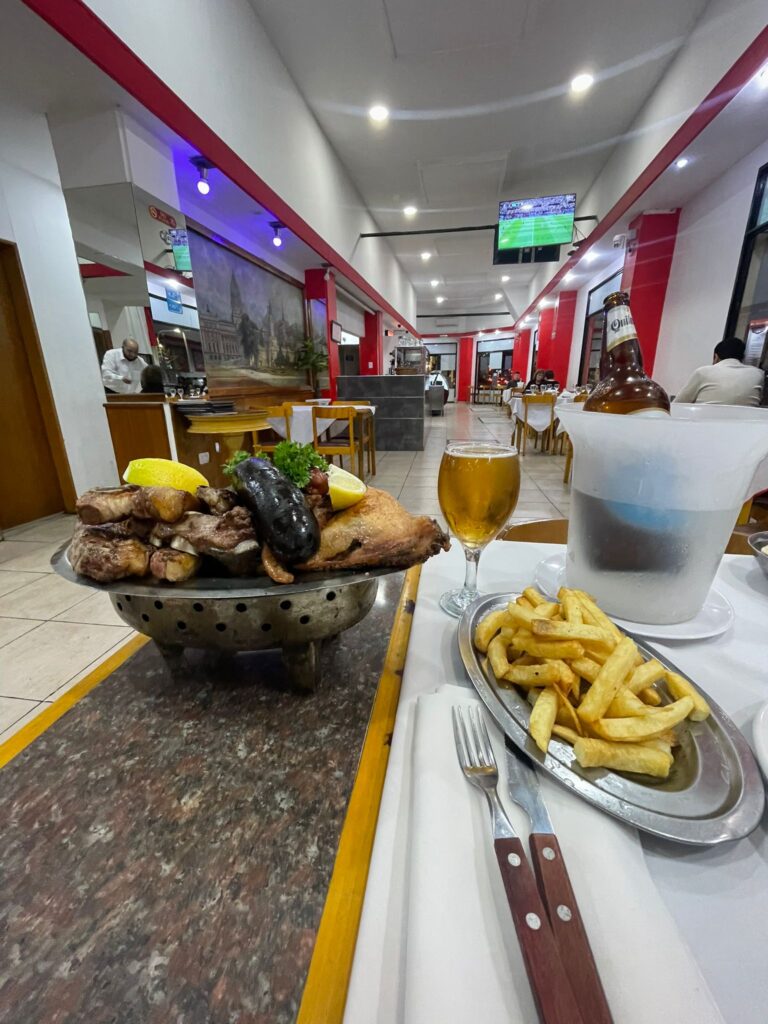How to Order Steak in Argentina
Disclaimer: Some links on this page may be affiliate links. If you purchase anything through them, I will receive a small commission at no extra cost to you! Further details in the Privacy Policy.
An Introduction to Argentine Steak
Argentina is the steak capital of the world, which made it by far my favourite country for getting stuck into the local cuisine.
But it can be a little intimidating to order Argentine steaks if you aren’t familiar with the different cuts of meat. Likewise if you don’t know how to ask for a rare, medium or well done steak then you could end up with something you didn’t order. Fortunately I can help you learn how to order the perfect steak in Argentina.
This post will teach you how to tell the difference between a vacio, cuadril or bife ancho. I will also explain whether you should order a steak “vuelta-vuelta”, “bien cocido” or something in between.
Lastly this post will cover how much a steak costs in Argentina (spoiler: not a lot) and where to find this popular meat which often caters to higher-budget travellers in other parts of the world.

What Are Steakhouses Called in Argentina?
Steakhouses in Argentina are also called “parrillas“. This word is Spanish for “grill”. Therefore the word “parrilla” means both steakhouse and grill.
Steak and various accompanying meats will be cooked on the parrilla by an asador (grillmaster). He will prepare the meats and grill them to perfection. The role of an asador is passed down from fathers to sons and is very important in the local culture. A son who cannot cook steak is often frowned upon by his peers.
The third and final term you will need to become familiar with when ordering steak in Argentina is asado. This word has two meanings. It is the process of barbecuing meats over a parrilla. It is also the name given to a barbecue gathering. It is pretty similar to the English word “barbecue”. In the UK your friends would invite you round for a barbecue. In Argentina, your friends would invite you round for an asado.
Got it? Let’s get stuck straight into what cuts of meat you can order in Argentina, and how to order them.
What Types of Argentinian Steak Cuts Can You Order?
There’s no shortage of steak cuts in Argentina. From Buenos Aires to Iguazu, to Salta to Ushuaia (which by the way, has some amazing activities), cow is king on the local menu. But how do you know which cut to choose? If you want to learn how to ask for Argentine meat cuts in English then you’re in the right place. Here’s a list of cuts your asador will serve up for you:
- Vacio: Flank steak. From the cow’s belly. My personal favourite, this one is common across Argentina (and neighbouring Uruguay which has very similar cuisine)
- Bife angosto/bife de chorizo: Sirloin steak with a layer of fat. This one is particularly filling and one of the most popular cuts across the country
- Ojo de bife: Rib eye steak, and a particularly large cut. Very tasty
- Bife ancho: Prime rib or rib eye roast. You can choose between having this with or without the bone. A tender and well-marbled cut
- Asado/tira de asado: Short ribs. The asador will generally slice right through the bone in this tender cut. You can go for an asado to have asado for asado. Confusing right?
- Tapa de asado: Rib cap. A tougher cut of steak, often served in small slices
- Tapa de nalga: Top of round roast. A slightly tougher cut found just below the vacio
- Picanha: Rump cap. A tender cut with a layer of fat on the outside. Can sometimes be served on a skewer
- Colita de cuadril: Sirloin roast. One of the most affordable cuts in Argentina, this is a lean cut of meat with a lot of flavour
- Cuadril: Rump steak. A chunky cut. Lots of meat on this one making it good value for money
- Punta y pecho: Beef brisket. Full of fat and flavour, this can be a trickier cut to slice
- Entraña: Skirt steak. A long, fat and juicy cut of meat that’s often tender on the inside
- Bife de lomo: Tenderloin or Filet Mignon. Another tender and juicy cut. Highly recommend asking your asador for this one
- Peceto: Eye of round. A very lean and slim cut, shaped similarly to a sausage
- Matambre: Flank steak. Not to be confused with vacio, this is a very thin cut taken from between the skin and ribs of the cow. It is often stuffed with vegetables or other ingredients in a dish known as matambre arrollado
- Churrasco: Skirt steak. A tough cut of thin meat that is served boneless
And there you have it. A list of Argentine beef cuts you can expect to find at your local parrilla. I’m no foodie, but Argentina is the one country where I would travel halfway across the world purely for the food. Yes you can find Argentine steakhouses dotted around the world, and various steak cuts in other countries. But trust me when I say the land of Messi and Maradona does it better than any other country.
Paraguay and Brazil also have some pretty awesome steak, but as soon as you cross the border to Puerto Iguazu, you’ll be in the home of the best in the world.

What Comes With Steak in Argentina?
As delicious as it may be, your Argentine asado will often come with a bunch of other foods. Of course, in this nation of meat lovers, you can expect your meat to come served with more meat. So let’s start with these extra meaty options, or offal dishes.
Offal
- Chorizo: Sausage. Literally a pork sausage, and commonly served at your local asado
- Morcilla: Blood sausage. Made from pig or cow’s blood (hence the name), often mixed with fat and seasoning. Personally not a fan of this one
- Chinchulines: Small intestines which are easy to tell apart from other meats due to their small circular shape. Must admit that I’m glad I first tried these before knowing they were intestines… they were okay, but nothing special
- Mollejas: Sweetbreads from the thymus gland of the cow. Often served alongside chinchulines
- Riñones: Kidneys. Loved by just about no one and often served with a slice of lemon. One for braver diners out there
Sauces and Sides
Believe it or not, Argentine asados do often come with some sides that don’t contain meat. If you want a bit of balance with your dinner, here’s what to look out for:
- Chimichurri sauce: Parsey, onions, garlic, oregano and vinegar are often found in this green-coloured condiment which is widespread across Argentina and Uruguay, two of Latin America’s safest nations incidentally
- Salsa criolla: Another sauce, this time consisting of onions, tomatoes, peppers, parsley, garlic, vinegar and olive oil
- Salad: Ensalada in Spanish, you can balance out your plate with something a little lighter by tucking into salad alongside your meat
- Provoleta: Melted provolone cheese which is grilled and served in a disc-shape. Often an appetiser coming before the main asado, they are generally seasoned
- Bread: No need to explain this one. It’s bread. Served at the beginning as you wait for the main meal to arrive
- Papas asadas: Grilled or roasted potatoes. They often come seasoned with herbs
And that’s just about everything you can expect to find alongside your meat in Argentina.
For a drink, the locals love to wash down their steak with a glass of wine. Argentina is one of the biggest wine-loving countries in the world. Mendoza is the heart of Argentina’s wine industry, and the perfect place to visit for wine lovers, with vineyards and restaurants in abundance. However, wine is served alongside steak in any Argentine steakhouse you can find across the nation.
If you don’t fancy wine, then perhaps Quilmes, the country’s most famous beer will take your fancy instead. Despite being a beer fan myself, in Argentina, it doesn’t feel right to eat steak with anything other than a good glass of wine.
How Do You Ask for Steak in Argentina? (Steak Doneness Guide)
In Argentina, you cannot rely on the locals being fluent in English. You will need to learn a little Spanish to get by. Now this post isn’t here to tell you the difference between “hola” and “gracias”. Rather, it will inform you how to order blue rare meat, a cut as brown as your coffee, or anything inbetween.
Without further ado, let’s get into the terms you need to learn so you know how to order steak in Argentina..
- Vuelta-vuelta: Steak so blue it looks like a smurf. Okay, maybe not quite, but this is what you should ask for if you want your steak as rare as these Pokemon cards I spotted in Tokyo
- Muy jugoso: Very rare. A steak so pink you’d imagine this would be Barbie’s dinner of choice in Argentina. Full of juices too
- Jugoso: Medium rare. Still pink, still juicy, the most cooked of the three rare options… but it’s still rare
- A punto: Medium. Not too pink, not too brown, still a little juicy, but the best of both worlds
- Cocido: Well done. This is where you want to start off if you want to eat like a real Argentinian. They love their steaks to be well done. Still a little pink however
- Bien cocido: Very well done. Steak drier than a Saudi nightclub. If you want to colour coordinate your steak with your cup of tea then you want to ask for “bien cocido por favor”. Another popular choice amongst the locals
If you want to order steak that is jugoso, muy jugoso or vuelta-vuelta then expect looks of confusion or even horror from the asador. Argentinians do not do rare steak. Perhaps in a more touristy part of Buenos Aires such as La Boca, you may not be greeted with such derision. But the word “cocido” is the fastest way to end up with a pleased Argentinian asador during your trip to the parrilla.

How Much Is a Steak in Argentina?
Argentina is the cheapest country in the world to buy a steak. This traditionally expensive dish in almost every country is readily available for those on a budget here.
There is some bad news however, and that is that Argentina has one of the world’s most volatile currencies with exchange rates, inflation and prices shooting up at unpredictable rates. Skip to the bottom of this section if you don’t want to read a boring economics overview and only want to know what it means for steak prices. Although I’d advise reading on so you don’t miss some important information.
For years now the Argentine economy has been in crisis. During my own visit to the country in late 2022, US$1 could be exchanged for around 150 pesos using the official rate. Yet there is a black market economy known as the “blue dollar” where you can exchange money for much more favourable rates. During my visit the blue dollar rate was around US$1 = 280 pesos, therefore almost double the official rate.
However the December 2023 arrival of newly-elected president Javier Milei saw the economy blast even further out of control. He removed price controls which led to supermarket prices doubling within days. This alongside the pesos’ devaluation led to inflation becoming far worse.
These actions have been bad news for the blue dollar. As of February 2024, the official rate is US$1 = 814 pesos and the blue dollar rate is US$1 = 1,065 pesos. These prices will fluctuate daily and be completely different when you read this post, even if it’s within days of publication or the latest update. Therefore be sure to check the blue dollar website for the latest rates.
Now, the problem with this situation is that it may mean your bargain steak is no longer possible to find here. Argentina was once comparable to western Europe in terms of prices. The economic struggles of recent years have been terrible news for Argentinians, but brilliant news for tourists. For this reason it was easy to find high quality steak for under £10/US$12 all over the country. Yet the recent price fluctuations mean a good steak may cost a price closer to those in neighbouring Uruguay now (previously double the price of an Argentine steak, as of my visit in late 2022).

Where Can You Find Steak in Argentina?
The good news is that you can order meat almost anywhere in this wonderful country. Restaurants can be found everywhere, and even without being a specialist parrilla, steak is often on the menu. However, I would strongly advise visiting a proper parrilla for the best experience.
Street stalls are commonplace in more touristy areas. They also sell vacio, bife de chorizo and other popular Argentine steak cuts for the same quality as an upmarket restaurant. Resto Bar Las Gemelas in La Boca was a personal favourite of mine. There was also a fantastic Chile-themed market in Mendoza I’d love to recommend, although that was just a temporary event unfortunately.
Even in somewhere like the German-themed Villa General Belgrano, you can find steak alongside the bratwursts and schnitzels the village is best known for.
Patagonia on the other hand is more famous for lamb than asado, although you can still find Argentina’s incredible steak down there. Follow my 2-week Patagonia itinerary for more information on the food available there, as well as the wildlife and things to do.
Now in the capital Buenos Aires, you can find the world’s 19th-best restaurant, or the 4th-best in South America. Don Julio is the name of this famous spot. Be sure to book a table up to 3 months in advance however, demand heavily outweighs supply here. I have heard that it may be possible to get a table when the restaurant is fully booked by contacting them on Whatsapp. However this is of course subject to availability and possible cancellations.
Even without a Don Julio visit, I recommend a good steak even if you just have a day in Argentina’s capital.
Eating steak in Argentina is about the social experience just as much as the food. It is an important aspect of the culture in Argentina and other Southern Cone countries (Paraguay, Uruguay, Chile) where asado brings friends and families together.

One Final Tip on How to Order Steak in Argentina (Ask for Spanish Menus)
Many restaurants in touristy areas will give you menus in English. This is especially true in touristy parts of Mendoza, Buenos Aires and other parts of the country popular with foreign visitors.
Unfortunately, these often come with an added “gringo tax” where foreigners end up paying more than local Argentinian diners. To avoid this, you should always ask for the menu in Spanish. Say “una carta en español por favor” (a menu in Spanish please). If you don’t understand, use the Google Lens feature in Google Translate to help you out.
This will help you keep the cost down in an already affordable country. Don’t miss out on Argentine asado during your trip to one of my favourite countries in the world. You can follow my 3-week itinerary for Argentina for some tips on the best places to visit.
Hopefully this guide has given you all the information you need on how to order steak in Argentina, so you can enjoy the local food as much as I did.
More Posts on Argentina
- A 2 Week Patagonia Itinerary: From Ushuaia To Bariloche
- Best Things To Do In Ushuaia: Don’t Miss Out On This Gem!
- Cafe Tortoni: What To Expect In The Famous Buenos Aires Cafe
- Money In Argentina: How To Get The Best Rates In 2024
- The Ultimate Guide To Visiting Iguazu Falls (Argentina Side)
- Iguazu Falls Border Crossing: How To Cross The Triple Frontier Between Argentina, Brazil And Paraguay
- A 3-Week Argentina Itinerary: From Mendoza To Buenos Aires
- What To Do In Villa General Belgrano?
- Top 5 Things To Do In La Boca, Buenos Aires
- Safest Latin American Countries To Visit In 2024
